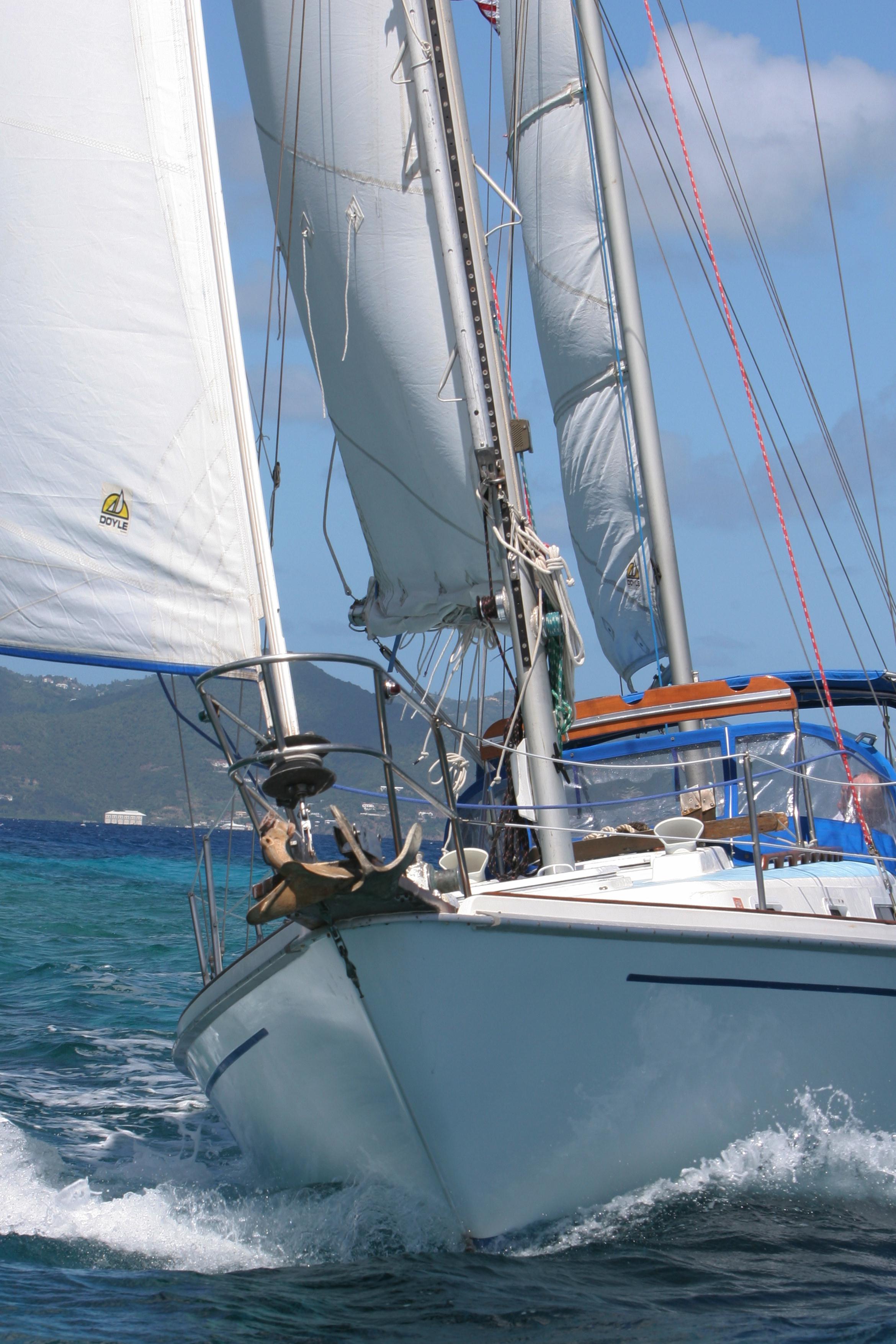
Sea Quill

June 16, 2007
Hi Howard,
Hope you are doing well and having a great summer. Don't know if you remember me but we sent some emails to each other in Nov-Dec last year when I had just bought Sea Quill. Anyhow we have now lived on the boat since late December last year and we have had an fantastic time so far (and some less good times as well of course...). We have been sailing from Dominican Republic to Jamaica, Cuba, Belize and now we have just arrived in Livingston Guatemala. Have to say that we really love the boat it has been such a pleasure and we have sailed nearly 1500 nm so far and learning more and more about Allied Seawind. Still we feel like new beginners.
Just checked the Allied Seawind website and wanted to ask if you could update the owner information for Sea Quill 29, and put in our website.
Regards
Ulf and Jen on Sea Quill.
"It doesn't get better than this!"
"Sea Quill is every bit the pedigreed Allied Seawind Mk II Ketch and a LOT more. Her owner, a pleasure boat, marine professional, has spent the last 15 years rebuilding her and perfecting her. You've never seen an Allied Seawind like this one.
That's what $100,000 can do to make a great vessel into a perfect work of art. Sea Quill is gorgeous because everything is absolutely perfect. She shows like a dream come true.
First of all, she's a true classic. "The Allied Seawind Mk II is one of those vessels that have stood the test of time. Tom Gillmer drew a near perfect shear line. It sweeps up attractively to a high buoyant bow and stout bowsprit." Vigor says, "She exudes an air of power and purpose." I could not say it better. Her proportions are just right. She has ample freeboard, a perfectly balanced coach roof. She has the interior headroom and voluminous space without compromising her classy look.
This Allied Seawind has all of that pedigree, plus she's become a work of art! Sea Quill is well outfitted as a proper sailing machine! She has a new custom suite of sails, she is notoriously fast. Even in very light airs she performs very well. And in heavy conditions, she's stable, and surprisingly stiff. And she gets a high comfort rating with plenty of room. Seawind owners all report incredible heavy weather performance and John Vigor gives her a safety as sea rating of #4 out of the 20 vessels he recommends as the worlds best values in affordable, pre-owned cruising sailboats."
The money spent on Sea Quill was well spent! Check out the short list of just the Structural and Safety Upgrades:
1. Amidships, the thwartship bulkhead reinforced from the original 3/4" to 1.5" joined contiguously with full width galley counter to provide very stiff amidships dimensional stability. 2. Coach roof and liner epoxy-joined at every port and hatch. 3. New standing rigging and chain plates 4. Two overhead and four opening hatches removed, re-glazed, re-sealed and powder coated. 5. Custom port and starboard interior grasp rails, fabricated, pre-stressed and installed to add greater structural support to side decks while bringing her lovely shear line into the interior accommodations. 6. Additional support added to rack and pinion steering bridge under aft cockpit locker. 7. Custom aft rode locker installed stbd. aft 8. Custom vented (Seaward Marine), propane locker Safety 9. Doubled (modified) SS rail pushpit and pulpit 10. 30-inch lifeline stanchions 11. Coach roof grab rails, removed and refitted, 2003. 12. Main salon settee lee cloths (2). 13. Three fire extinguishers. 14. A full set of Type II life preserver PFD's. 15. Mast mounted anti-collision strobe 16. Custom, full length grasp rails on the interior cabin sides 17. Custom teak grab rails at stove and nav station 18. Custom Stainless steel crash bar at stove 19. Boom gallows
Three decades ago, Alan Eddy had that dream. He was a regular Joshua Slocum! He was the first sailor to circumnavigate the earth in a fiberglass sailing vessel. That vessel was an Allied Seawind ketch, a 30-footer named "Apogee". The logical successor to that 30-footer was the Mark II version, a 32-foot with vast improvements. Many of the rare Mark II's have made ocean crossings and circumnavigations that only serve to prove the capability of this stout little ship.
If you yearn for adventure, you need to know that it is not far away and not out of reach for you too, even on a slim budget. You can do it just like so many others who've sailed far and realized their dreams of freedom and adventure.
Comments from other Allied Seawind owners:
"...a unique interior that speaks of Artistry, Function and Comfort."
"Paul has treated this lady as if she were the ONLY lady in his life."
"A work of art"
"We can all be proud of this Seawind II."
"Each little touch has been thoughtful as to function as well as eye appealing design."
Builder-Designer Specs, Equipment and Information:
|
|
|
|||
|
Builder: Allied Seawind |
Designer: Tom Gillmer |
|||
|
Dimensions |
||||
|
|
||||
|
LOA: 32' |
LWL: 25'6" |
Beam: 10'5" |
||
|
Displacement: 14,900 lbs |
Draft: 4'6" |
Ballast: 5,800 lbs |
||
|
|
|
|
||
|
Engine |
||||
|
|
||||
|
Engine(s): Yanmar |
Engine(s) HP: 27 |
Engine Model: 3GM30F |
||
|
Hours: 1150 |
Cruising Speed: 5.5 knots @2100 RPM |
Max Speed: 6.5 knots |
||
|
|
Fuel consumption @ 1900 RPM. .348 GPH, 4.9 kts. |
|
||
|
Tankage |
||||
|
|
||||
|
Fuel: 40 Gal New Aluminum |
Water: 60 Gal Monel Tank |
Holding: new, unused Lectra-San, treatment system. |
||
|
|
|
| ||
| ||||
|
|
|
|
|
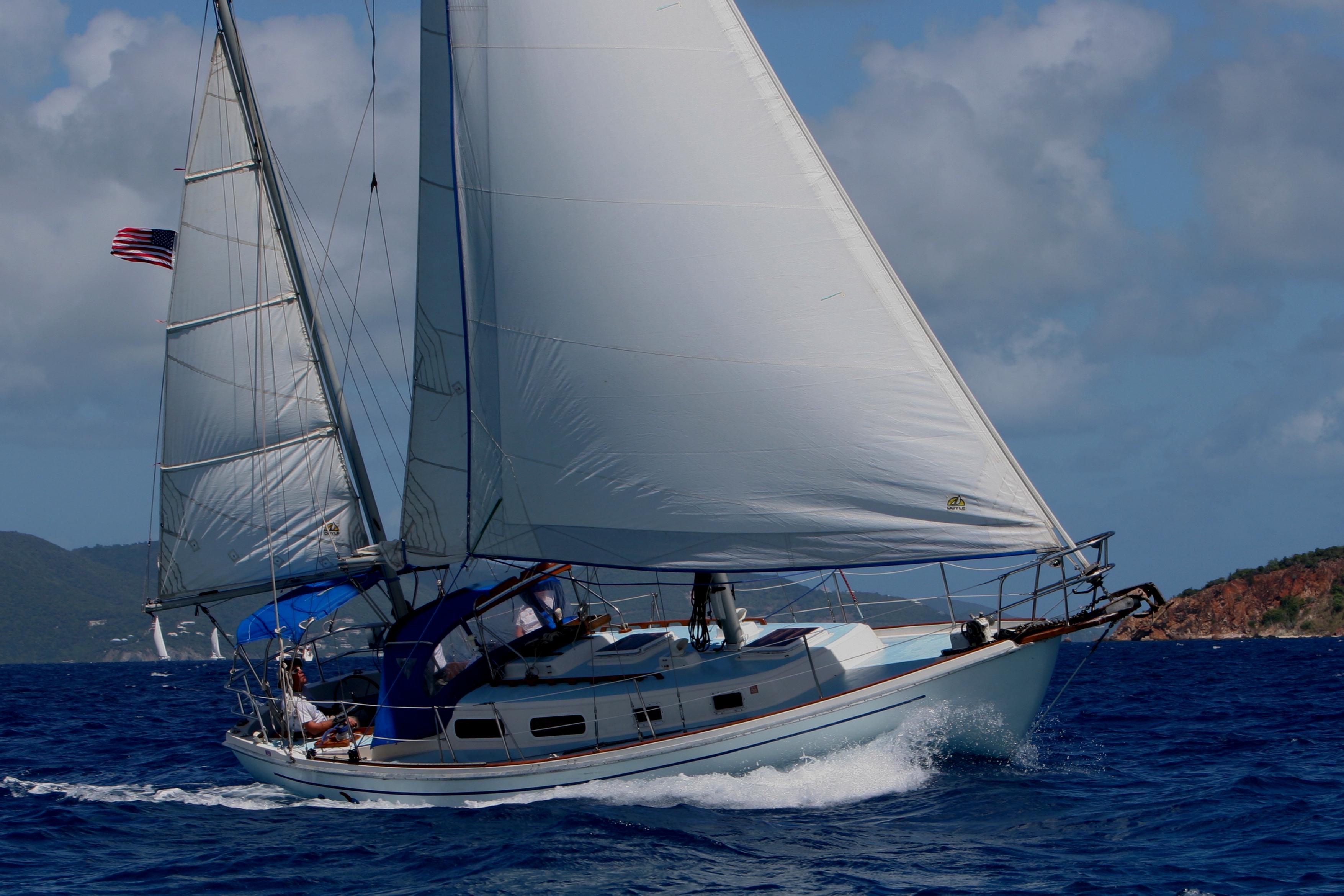















Karen.
Thanks very much for once again remembering the Seawind II as one of the most durable, "Good Old Boats", in John Vigor's article in the past issue. He has offered your appreciative readers a fine representation of this, almost perfect, good old cruiser that has yet been written. His views are almost universally, accepted and agreed upon by myself and those other 127 owners of the Tom Gilmer classic.
Within his comments Mr. Vigor has noted some of the "Known Weaknesses". It would be hard to disagree with his short list and easy to add just a few more.
I have taken a rather inventive and very aggressive course regarding my solutions to these and others. Many of which are fairly well documented in the Seawind II web site, mentioned, that Howard Hering has so remarkably maintained.
However, I must make mention that the very truthful observation regarding the serious lack of engine access is one that I have taken my most aggressive, creative and successful steps to cure.
However, my solution(s) is one that may be applied to a host of good old boats that suffer from similar design deficiencies in other venerable older designs such as the Luders 33 and many others.
In addition to my unique removable cabinet solution, I have decided to remove my dual, 12VDC and engine drive refrigeration systems, with its bulky compressor(s) in favor of the new, and remarkably efficient, Sea Frost BD 35, 12VDC system. The advantages begin with increasing starboard side engine access by eliminating the bulky, belt driven, compressor and its related plumbing from the front of the Westerbeke 30.
It took the job of creating more engine access into fully investigating the real truth of the claimed 4"of insulation (as described by the factory) in the "ice box".
I began by removing the entire guts of the original box and replacing the insufficient average of 2.25 inches of open-cell, expansion foam and glass-wool insulation, with two layers each of two inch, R-10, closed cell foam insulation to substantiate the conversion. The compressor/condenser unit fits easily, forward, in the port cockpit locker on a small shelf immediately aft of the galley. The 1/2" thick evaporator unit disappears into the box leaving an additional .5 cubic feet of cold storage in the new space.
Even more engine access was created by the removal of the old hot water heater and replacing it with a standard refrigeration condenser, supplied by Sea Frost, as a hot water loop transferred from the engine cooling system. Hot showers are conveniently available, with the engine running, during battery charging time.
Paul Watson,
New York
SV GiGi, Seawind II, Hull # 29
December 8, 2000
See Westerbeke 2
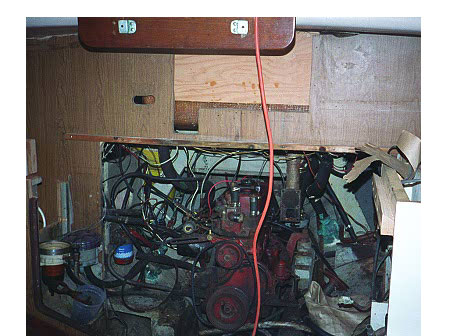
Starboard Waist 2
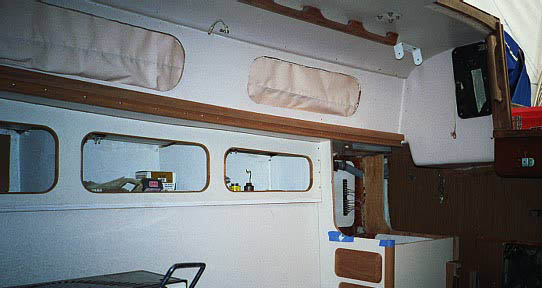
Table Leg Detail
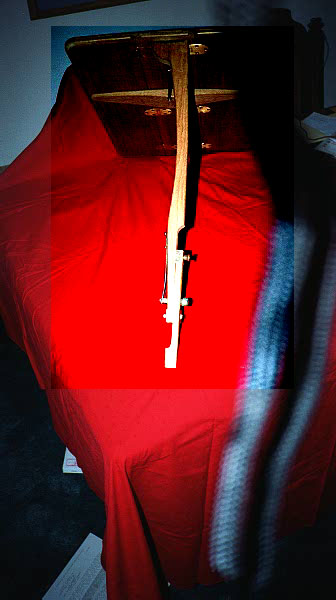
Table Opening
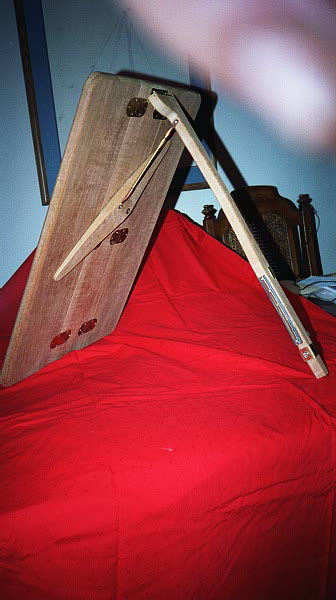
Table Tucked Detail
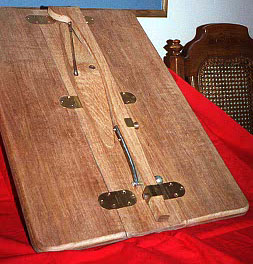
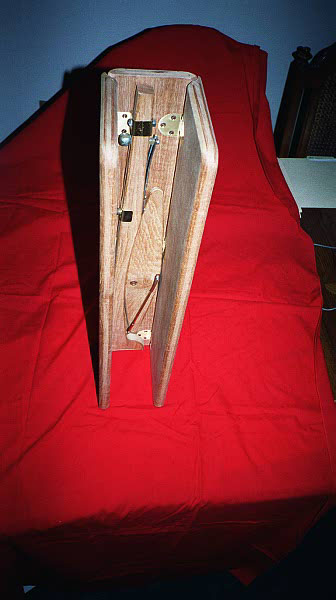
November 1, 2000
The Allied Seawind II has often been touted as one of the ten best, small cruising boats available today. Its design is the logical and refined, evolution of her noteworthy, predecessor the thirty-foot Seawind. This venerable earlier Tom Gilmer design boasted the remarkable accomplishment of being the first production fiberglass sailboat (Apogee) to circumnavigate the globe. Several other Seawind Mark II s were to follow including possibly the most heralded voyage of Scott and Kitty Kuhner in their ketch, "Bebinka".
The high, sweeping shear line highlights her distinctive profile. A proportional, straight coach roof accents a remarkably low freeboard amidships that begins the returning rise aft to a beamy heart-shaped transom. At ten and a half feet the ample beam carries well aft from the distinctive, broad flaring bow through the massive cockpit area and drops almost vertically to about a foot below her waterline where the chine turns towards a magnificently shaped full keel with a very modest forward cutaway. The ultimate result is to create an interior volume that allows more than 75 inches of headroom within her wide main salon and 72 inch by 80-inch vee berth.
By modern standards the four foot six inch draft certainly inhibits tight upwind performance but Gilmer intended her for long distance cruising with the most comfortable sea-motion that could be achieved and certainly did that. From the close reach to the broad reach the Seawind II easily exceeds her theoretical hull speed and will carry over seven knots, in eight foot swells and a two foot cross chop with total alacrity.
The Allied Boat Company of Catskill, New York, first began production of the thirty foot Seawind in 1962. The company produced not only the first Seawind to circle the world, christened "Apogee" but also the Luders 33, "DOVE" that carried the youngest circumnavigator, of the time, Robin Lee Graham, around. Even as the Allied Boat Co. built undoubtedly some of the strongest hulls of the time, (others included the Wright 40, the Mistress 39, the Allied 39, the Princess 36, the Seabreeze 35, Greenwich 24 and the Chance 30), the company was to be constantly plagued with financial difficulties and a failing management structure and was saved from their debtors by bankruptcy seven times. In 1975 the company went out of business with at least 22 ordered boats uncompleted. The Wright Yacht Company purchased it in 1975. From 1977 to 1981 several more business owners tried to continue the work of the original builders with final failure in 1980 at the hands of a group of former managers from the original Wright Yacht Company. The effort failed and the company was to close permanently in the summer of 1981. During those 19 years the company was to produce only 129 Seawind II's.
Even as several production runs of the Seawind II Wright-Allied was only to finish 129 of these hulls in sloop, cutter and the more popular ketch, the graceful and remarkably sturdy hulls seemed the only consistency that allow these nonetheless remarkable boats to flourish with an almost cult-like demand in the brokerage market.
Hull # 29 was born in 1976 and began a cruising life almost immediately with her owner Gerry G. Smith who christened her GiGi. She was to leave her birthplace on the Hudson River in up-state New York to arrive in New York Harbor in time to participate in the 1976 Bi-Centennial Op-Sail festivities. From there the Smiths sailed south to the Chesapeake for some extended cruising and perform the extensive modifications and install the extensive equipment list that Gerry had painstakingly planned.
She was then to travel to Bermuda for an extended stay and then on to the Caribbean for several extended cruises, over a period of several years, that left almost no island un-visited. Often Gerry would haul her in the Virgin Islands and leave her for a few months and then return for more exploration of his beloved Caribbean cruising grounds. His plans were ultimately to take her to the vast Pacific for even more mileage.
During the night of September 17th 1989 GiGi was shored up in Totrtola, awaiting Gerry and his family's return, when the fury of Hurricane Hugo swept through the Virgins leaving massive destruction in its wake.
GiGi was repeatedly rocked violently against her archaic wooden braces forcing them into the sodden ground. The bracing ultimately failed and GiGi tumbled into another yacht to her starboard, causing a domino effect that left ten grounded yachts heavily damaged and tangled in their respective rigging.
Remarkably, as she struck the ground the soggy earth cushioned her fall and protected the sturdy little hull from certain damage. Her mainmast snapped at the spreaders and both the bow and stern pulpits were destroyed but none of the structural bulkheads had been disturbed.
By September of 1999 GiGi had long been returned to vertical, in the same type of wooden shoring, with the local vegetation growing almost to her gunwales. She seemed to be one of the last vestiges of the myriad of damaged boats left in the yard. The upper half of her mast still dangled from the last attached, remaining, distorted piece of aluminum and remained hopelessly tangled in the remnants of her standing rigging. Little had been done to ensure her future other than to rearrange the loose equipment within her main salon so that a pathway could be found to move through the boat.
She cried for help and I wanted a cruising boat.
Gerry and I, after some impassioned, faxed communication, struck a deal that ultimately resulted in our partnership in the wonderful little cruiser. I was to repair her and we were to mutually enjoy her during contractually defined seasons of each following year.
Her structural and mechanical resurrection began in December of 1991 and the hull was launched in mid-January. The successive seven years of part-time work were augmented by the immeasurable efforts of the close-knit expatriates and many wonderful locals encountered during my lengthy stay on the island.
I moved aboard GiGi almost immediately and after some Herculean efforts to splice her mast and repair her most immediate sailing necessities she eagerly slipped out of Road Town one magnificent afternoon later that month for her first sail in over five years. The brief sail out to Norman Island and back to the dock cemented my resolve to ultimately produce the finest example of a Seawind II in existence and to ultimately depart for the world at large. I knew she was capable and comfortable and if she was willing to go I would go with her.
The naturals fortunes of life had prevented Gerry Smith from ever returning to the islands to execute his option to sail her. Similar turns of events allowed me to eventually make an offer for purchasing my half of the boat and I threw a "Burn the Mortgage" party at the yacht club in 1998 for all of those friends that had helped to maintain my resolve and sanity during the seven previous years.
The liveaboard aspect certainly hinders livability during the seemingly endless, ongoing process of refitting any yacht but we managed until August of 1998 when during a visit to New York I was to realize that my health would soon signal the end of the ultimate plan to explore the distant shores of every landfall I had envisioned for so long.
In July of 1999 GiGi was sailed to New York by professional delivery skipper and close friend Jerry Leclare. His comments regarding her incredible sail plan balance and innate ability to hold a course for hours and days without but minor trim adjustments didn't surprise me. He recounted the second leg of his voyage from Bermuda to Montauk Point, Long Island, New York as a constant gale for the last two days, diminishing only as he neared Montauk. He carried a deep reef in the main and rolled up only about 20% of the new 125% Doyle jib and sailed on at an average of almost eight knots. "She's definitely a great sea boat" he exclaimed when I met him at his landfall in Shelter Island, New York.
GiGi had typically been shaken up during the rough delivery. The fixed ports in the main salon had worked their GE 5200 bedding loose after eight years and the sea water had soaked through the 1/4" plywood trim panels that had been installed as fascia and mounted on the inside of the cabin sides twenty three years before. Seawater had coursed through the chainplates, that had been replaced and re-bedded nearly five years earlier, causing some further delaminating of the locker doors in the head as well as the head's mounting platform. The raw water pump bearings had given up halfway to Bermuda and Jerry had rigged an electric pump to aid the cooling flow but she trundled on gallantly. In short she was a mess but had suffered nothing other than minor cosmetic damage to the original joinery installed in 1976.
The logic of performing a major cosmetic refit on an aging yacht, that in the foreseeable future likely will be in search of a new owner, seemed to escape most of my friends when I mentioned that I would undertake to drastically alter most of her interior. They pointed out that the Seawind II had enjoyed a fine reputation with her owners and most knowledgeable boaters for more than 25 years and would still bring a fine return even considering her relatively shabby interior cosmetic condition. I was steadfastly un-swayed.
I had lived aboard her for almost eight years and too often been defeated in simple maintenance tasks by incredibly limited access to the engine as well as had graphically envisioned an interior that went far further than the basically constructed and minimalist one that the financially desperate manufacturer had been able to provide in 1976.
Driven by both the vision of an interior that would be not only ergo dynamically be more comfortable, functional and inviting but also to find the Holy Grail of all Seawind II owners, provide better access to the engine compartment, I insisted that GiGi's final and crowning moment with me would be to enjoy the best possible results from my demands as well as the incredible mind, spiritual ministrations and precise workmanship of long-time friend, delivery mate and talented marine carpenter, Wayne Mantynan.
I had a very good understanding that Wayne was now married and raising two kids with a busy, full-time job as a project supervisor for a large, commercial construction company and would have limited time to dedicate to the project. This understanding would facilitate the time to fund the project at a rate that I felt comfortable with as well as to allow evolution of his fertile and creative mind to transform her. Without the timeless spirit imbedded within him to visualize the project through my requirements and create the artwork that has been his signature for over twenty-five years GiGi's refit would simply become another unqualified hatchet job.
Wayne signed on to crew for the day and a half delivery from Huntington on the North Shore of Long Island to a small yard nestled on the Amityville River on the South Shore late in October of 1999. He communed with GiGi sitting below, while underway, and began his own visualization. Upon our arrival at Steve Brice's, Yacht Service, Ltd., boatyard Wayne had already seen the beginning and was anxious to commence the job.
There seemed little to do for me other than to show Wayne to the engine compartment doors and ask him to reach for the dipstick, reach for the adjustment bracket the fresh water pump was mounted on, locate the heat exchanger stack or simply to access the secondary CAV filter on the Westerbeke 30that lived in there.
He got the message immediately and indicated that the designer clearly had managed to pencil in the galley sink and its supporting cabinet well encroached into the centerline without much regard for engine access.
I related the story of the day that two local, Guyanese mechanics and myself actually removed the engine into the salon, lifted it into a waiting dinghy with the main boom within one hour, all while on the hook in Road Town during a 25 knot breeze and a two foot chop. He laughed and said that maybe I should plan to remove the engine once a year, service all that it needed and reinstall it since it appeared to be almost as difficult a job as simply removing the starter.
Then I sat down on the starboard settee to show him that if I sat back I could not reach the table. The berth had been designed and built as an expandable pull out that was barely more than 40 inches wide when converted to a double using the cumbersome backrest cushion as a filler. Then I showed him the narrow bin stowage that existed behind the offending backrest bulkhead.
The last item that I had on my list was that I wished to replace the dark, wood-grained laminate that had been used throughout the boat. I had sanded and painted most of it in the forward cabin but had long abhorred the dingy darkness of the salon and galley area.
A few weeks went by and Wayne called me to meet him at the boatyard.
I arrived and climbed aboard for the conference I expected. To my surprise he had surgically removed the offending sink section of the thwartships cabinet that also contained, in the outboard corner, the refrigerator locker. The entire counter surface from the refrigerator to the navigation table/locker and all of the above counter locker faces had also disappeared. To my absolute shock I could see the entire port side of the Westerbeke including parts I had not viewed since the major overhaul it got back in 1995.
He explained that he was remaking this cabinet to be easily removable with the help of some quick disconnect couplers for the plumbing. His view contained many more features that are now works-in-progress.
All of the offending dark laminate has been removed from the vertical surfaces and bulkheads and replaced with a soft, eggshell white, counter surface grade laminate creating the instant illusion of far more volume in the main salon.
The port and starboard berths have had the outboard backrests moved inboard as much as three inches. In the case of the original "double" on the starboard side he has retained only part of the original slide out frame but modified it to swing out only at the aft end of the bunk to allow considerable and comfortable shoulder room making the bunk size wider at my widest dimension. While modifying the starboard side settee he noticed that almost no legroom had been offered in the original design between the companionway ladder and the tiny navigation locker in the starboard aft corner of the area. To offset this ergo dynamic deficiency he removed the square corner and laminated in a soft radius and increased the passageway be another three inches.
Above the settees he has created new and wider waist locker spaces with magnificently teak-trimmed openings for the custom made, teak-framed, rattan centered sliding locker doors. Each locker opening, with curved corners, tapers from narrow to widest as the space increases, following the shear of the boat forward.
Above the eye arresting waist lockers he had removed the delaminated fascia panels only to find that the original fiberglass cabin sides were in perfect if not somewhat perforated condition. With judicious placement of some narrow, complimentary moldings he will cover the original, installation drill-holes and accent the framing of the cabin sides. He turned his attention to the removal of the 25 year-old fixed ports and the weathered aluminum frames. As replacements were unlikely he sent them out to be sanded, filled and powder coated by his brother. The resulting workmanship and the pewter colored frames surrounding new, dark smoked Lexan port lights will, again bring the eye to the bright, wide space that has been illuminated.
Next, Wayne decided that he needed to define the area of the cabin sides with a more practical solution than simple molding. He took a page from so many of the heavy cruising boats and felt that another multi-purpose piece of joinery should be created. Heavily constructed, outboard mounted grasp rails adorn many Oriental built cruising boats just below the ports. As any offshore maven will attest to, there are never enough places to grab for when being tossed about in a seaway. His answer was, again, simply testament to his genius. Grasp rails were created with several functions in mind. They had to be strong but flexible enough to bend into the natural curve of the cabin side but not overpowering in width or projection. The consequence of natural condensation and leaks from ports or double purpose, overhead grab rails, mounted through the coachroof, is usually destined to cause damage to ships stores as well as joinery, as had already be evident during the offshore delivery. He created the rails as a gutter to direct the moisture aft into a small hose leader that carries the water to the bilge. Even as this seems trivial he constructed the grasp rails with a one inch, routed channel in the facing to allow a new wire chase from the aft salon forward. The routed channel is covered by an ingenious, thin, pop-in, mahogany insert that covers the wires and attaching screws.
The bending of these rails, during installation was so difficult that when finally fit Wayne noticed that the linear, structural improvement to the inboard area of the walk-around decks had stiffened the cabin sides significantly.
As he is a sailor his attention now turned to the navigation locker and recognized that it too had been designed with little purpose as a navigational work surface and more as a natural debris collector. This observation has been often documented in Sea Words, the owner association's newsletter, by many of the Seawind owners but rarely, if ever, has any owner approached the daunting task of redesign and modification to a more dedicated purpose. Wayne pondered the locker with a more global intentions and came up with yet another answer that would contribute to the engine access problem and provide yet two more surprises.
The forward facing vertical surface of the locker provided an opportune space to fill in with two long drawers as well as another that would project inboard below them. As he would be removing the three, minute drawers along with the tiny, existing engine access doors as well as almost the entire thwartships bulkhead, in order to create a massive new engine access hatch and new structural, support for the bridge deck and another for the proposed full-width countertop, the drawer space would become much more than it had been previously. To add to an already voluminous storage capacity he has built another, shallow locker, faced with white laminate and fitted with the now signature teak and rattan sliding doors to mount thwartships, full height, from the hull side on the starboard side extending to a spot just short of the companionway ladder passage. The depth of this locker is just the same nine inches that had been designed as a "wet locker" but always used as the "black hole". The small void created by the now unused, lower section of the wet locker has been modified to allow access to it from the engine compartment as an oil and fluids stowage locker using the natural curve of the hull as a delivery ramp to the ship's mechanic.
The two foot section of thwartships counter space between the new, custom lockers at the navigation locker and its complimentary companion to port side will be largely obscured by the ladder but will become a nine inch deep by twenty-two inch wide, hinged-up counter to allow even more top access to the my long neglected Westerbeke 30. Checking or topping off the header tank and filling the oil sump can now be done standing up!
Even as we have tried to be as artful and practical as deserving our combined visions, Wayne has added yet one final touch to the navigation locker. He seemed bothered by the new void left just outboard of the space consumed by the new drawers so he has taken on a new and fanciful project that seems to amplify his unusually talented capability. The laminated work surface of the navigation locker shall be split to allow a hidden, ten bottle capacity, wine rack to rise up from the void just about time for that occasional, evening taste test of my unusually obscure, eclectic collection of aged Hudson Valley wines.
The location of the electrical distribution panel had traditionally been below the companionway, under the bridge-deck, in the Seawind II. This location was always in the direct line of fire for an annoying drip and ensuing splash that occurs from the poorly designed drain from sea-hood as well as seawater from the occasional breaking sea mounting the deck, as again, documented by most of the owners. Similarly, the engine control panel was mounted in the forward cockpit, footwell bulkhead and again, susceptible to corrosion damage from frequent dousing. He has since removed both panels, closed the hole in the cockpit bulkhead and begun production of the new location outboard of the nav station where one would have logically placed it originally.
It has become my job to provide new wiring for all of the existing circuits to terminate at the new distribution panel location outboard of the new navigation locker. During my dismayed period of trying to envision a new location for those vital gauges and switches that the Westerbeke seems so attached to Wayne mused silently at my dilemma.
It seems only logical that unless the instruments are within the pilot's immediate and constant view they often go ignored. The answer seemed suddenly simple. The gauges would be moved to the coach roof, above the companionway. The idea has now evolved so that the answer to the instrument location also becomes the cure for the typically Seawind II moisture problem.
Wayne has agreed to create a low, compound curved, teak coaming that runs across the forward edge of the sea-hood and continues curving aft and finally reaches to both outboard sides of the coachroof and disappears to almost a "0" clearance at the coachroof horizontal extremity. The dodger will be fastened tightly upon the cambered, vertical surface of this coaming to help prevent water from entering beneath the previous, deck mounted fastenings. The coaming will then be configured with a shallow, watertight pod, built in on either side of the sea-hood, to contain the entire compliment of engine monitors as well as the Auto Helm Bi-Data instrument. Short fiddles will be installed both fore and aft as well as at thwartships, aft to help contain the inevitable small clutter that accumulates on both the aft coachroof surfaces. The waterproofed Start, Pre-Heater, fuel shut-off and the Power switches will be mounted on a vertical surface just below the steering wheel on the helm seat for quick and easy access.
It appears that I have become a bit more ambicious than I had originally planned but the results have so far been exciting and GiGi will be very difficult to part with upon completion. Maybe I will just be thrilled to sail her locally and show her off a bit. I will continue to keep you informed as well as provide supporting photos of the progress until her projected launching in May of 2001. Then I will be out sailing with no time to spend except muse over the magnificent result of mind and effort.
EOF 11/01/00
August 4, 2000
From Paul Watson
It has been an incredibly busy year for me and GiGi still resides in the yard here in NY. She is slowly transforming and the interior refit is exciting. Gigi is scheduled to launch next Spring. Hopefully, the new GiGi will emerge to sparkle and dazzle all of the SWII owners. She may not become another "Solution" but the modifications are quite stunning.
I have attatched some revealing photos of the work in progress with some comments in the form of an e-mail to my yacht broker, BVI Yacht Sales, in Tortola, British Virgin Islands and two prospective buyers. You are welcome to edit as needed for the website (I love it!).
As she is For Sale you may wish to include her in the website.
Within the cosmetic modifications came some functional changes that seem to address the problems of port side engine access, stowage and moisture problems in the electric distribution panel area.
I would be happy to discuss the details with you or any other interested party along with some of my more interesting approaches to other inherent design failures.
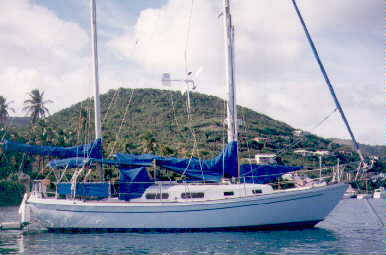
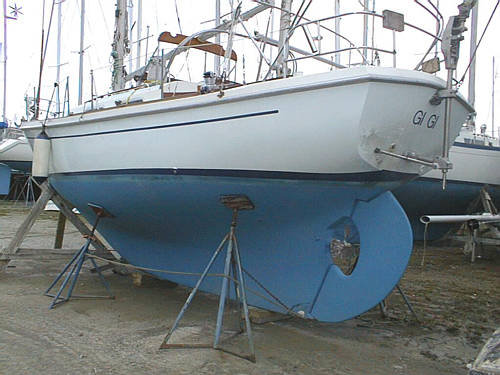
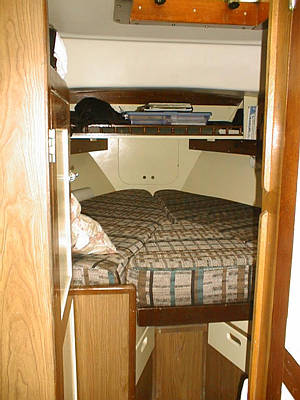
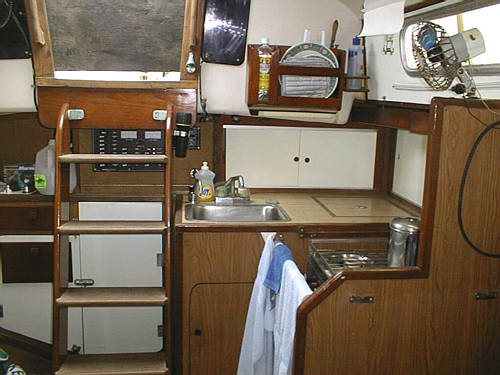
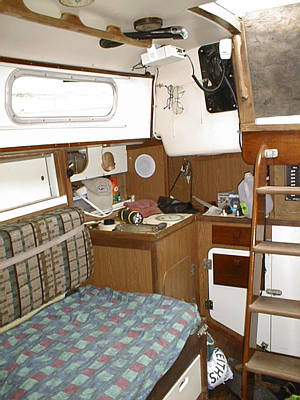
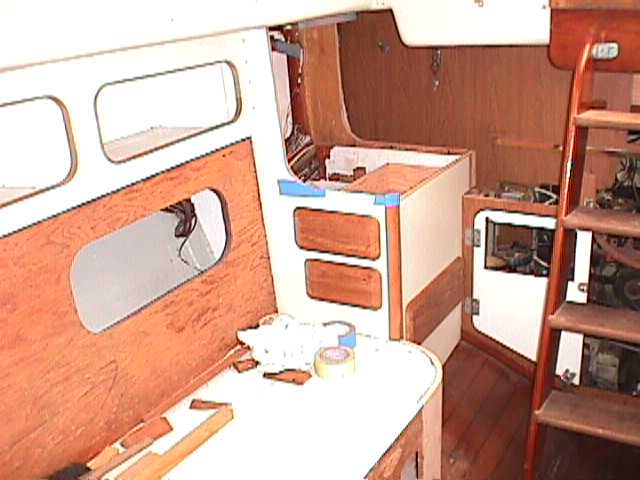
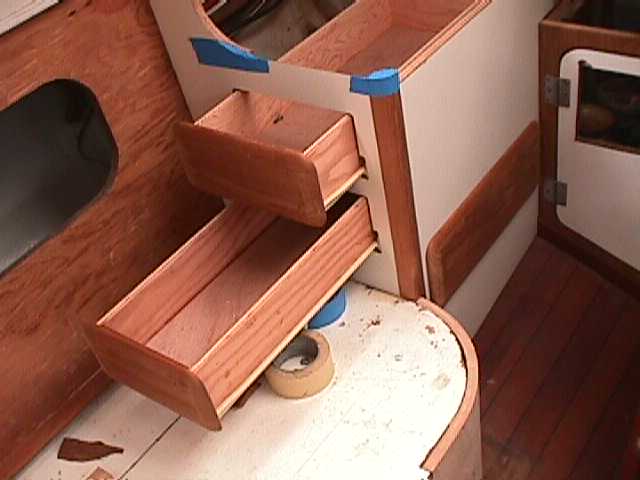
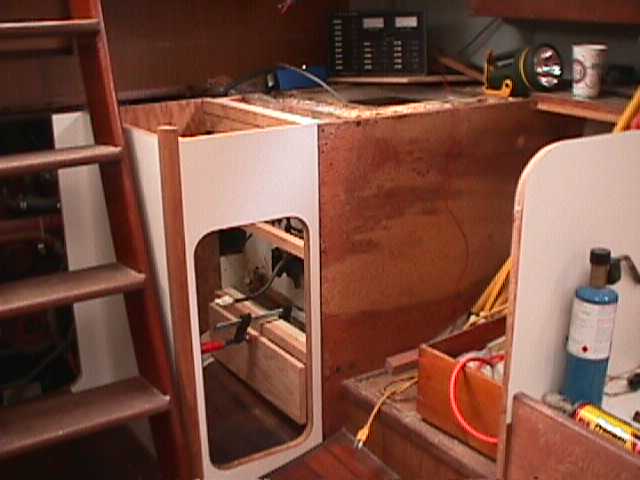

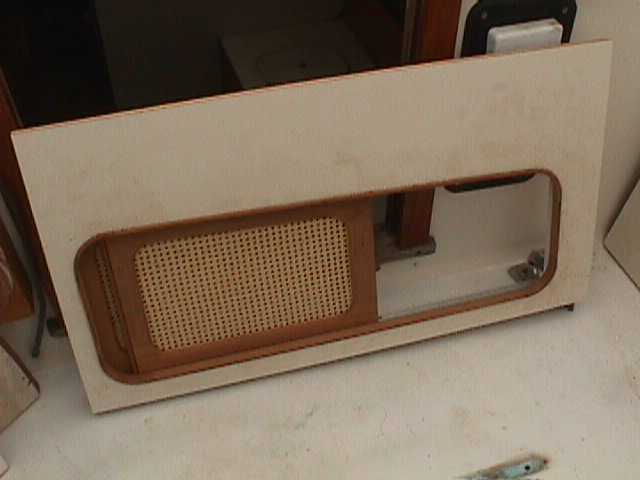
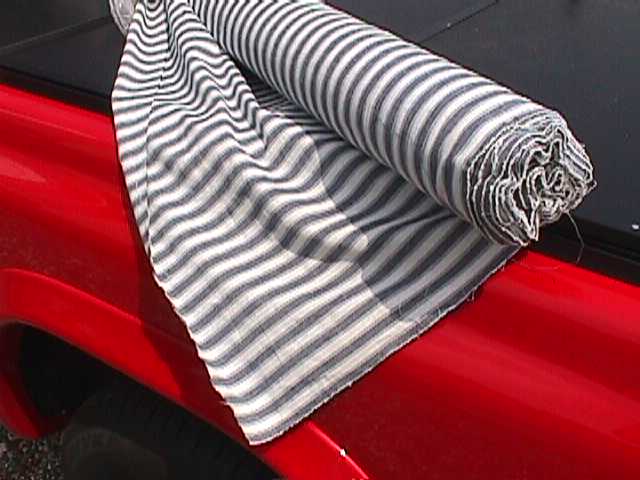
At long last I have arrived. This new web weenie and old Seawind II owner has found a place to set his anchor.
I am Paul Watson, hull #29 (k), the former partner of Gerry Smith and now full owner.
I have left my beloved GiGi, temporarily, in Tortola, British Virgin Islands while I attend to some important issues here in New York.
With your permission I would love to participate in the group, be notified of chats, allowed to provide the benefit of seven years of the revival of one of the finest small yachts I ever had the pleasure of sailing and now owning.
There appears to be a possibility that GiGi may come up for sale as my health has become an issue. I would love to turn her over to a true Allied Seawind II afficianado.
I have spent considerable time over the period 1991 - 1998 attending to the typical needs of a Seawind and seem to have permanently fixed many of the more difficult areas. I can even claim to have some SW & SW II racing results from the sunny Caribbean.
Sunday, February 14, 1999 12:48 PM
Thanks Howard. Unfortunately in my haste to depart Tortola I neglected to bring any photos of GiGi. But I'm sure photos of her sisters are quite available.
My trip to New York may ultimately be permanent and GiGi is now up for sale.
It breaks my heart to have put in so much work to have returned her from Hugo wreckage to a very sea worthy condition and not to have the opportunity to voyage with her.
The cost of delivery including the few extras she would need to make the trip exceed what I am capable of investing for the return and the decision is purely practical.
For Long Island Sound sailing, I fear, I may be forced to look at a more suitable design. A taller, more close winded sloop and probably fin keeled boat with lighter displacement may fit my available sailing time. As well you know Long Island Sound is an East West lying body of water that blows primarily out of the South West. I know I will miss the unparalleled sea kindliness of the Seawind II as well as the interior comfort but the replacement will not be a liveaboard or an ocean cruiser.
I have been fortunate to have sailed her extensively in the West Indies and even during the fabled "Christmas Winds" of 35 knots, to and from St. Croix in mountainous seas with nary a drop of water in the cockpit. She has faired well in the selected race events in The British Virgins (those that favored cruising boats and large off wind courses). She has won the fabled Sweethearts Single-handed event on two occasions and place well in the crewed race each year. A note here is that although recently upgraded to a local PHRF of 248, she sailed her previous events at 237 and always did well in moderate to heavy air. Recently, a new long distance event, the Tortola to Anegada spring time race allowed me to reach from Anegada Tortola at an average speed of 7.1 knots over a 17 mile leg with the new 125% headsail 15 - 18 knots of wind.
This sail design was of my own insistence after having sailed and analyzing performance under her original 150% and the 100% working sail for so many miles. I went for a full hoist luff for power, shallow draft to pull her a bit further upwind and reduce the leeway. I added a high cut clew to offer visibility and resistance to breaking waves over the bow on the beat. All of this was fitted to her oversized Hood furler. The improvement was dramatic. The sail is used in air from about 14 knots through 25 knots with great ease and comfort.
The other change I had made was to design a cruising mainsail that performed far better than expected. I had been repairing batten pockets at a regular rate with the old main due to a poorly matched slot with both the working sail and the big Genny. No amount of leach cord adjustment or sheet adjustment ever fully stopped the constant flagging. The new sail was built with a slightly hollow leach and no battens from 10 1/4 oz. cloth from the storm reef down and heavier cloth above. The big difference came by freeing the foot and providing only an outhaul car in the boom track. I went with two unconventional reef points. The normal first reef was set at 30% reduction because she handled a full main easily to 27 knots and the deep reef was set at two-thirds up the luff. The loose foot allowed a wide range of sail shape adjustment to accommodate draft and power ranges far better than the original main and almost fully compensated for the loss of seven square feet of surface.
I had raised the mizzen boom 14 inches to allow a bimini frame to be built under it and last year built a full battened, maximum roached mizzen that fit the new dimensions. The change in control and balance, again, was dramatic. Lazy jacks on both main and mizzen finally made her a true single handed yacht.
Since I was a liveaboard, she sat on a mooring most of the time. In tropical climates keeping the interior temperature tolerable was very important to ones comfort. Circus tent awnings only proved dangerous when the wind piped up and the attached cords and stays only interfered with moving up the deck as well as time consuming to douse when the winds prompted. My solution was, again, too good to be true.
Gerry Smith, the prior owner, had designed a soft forward hatch scoop that kept the Vee berth dry in all but the most severe driving rain. I describe it as an inverted wedge with an opening that fit snugly over the hatch coaming and lashed at four corners of the frame. The hatch provided the vertical stability for the matching back and two elongated, triangular side panels. Two lanyards were lead from the two front grommets forward to the bow rail so the "roof" panel was angled slightly downward and easily tensioned. Once the hatch was opened to the vertical position and the struts screwed tightly it becomes almost rigid. As it was worn when I got the boat I replaced it but change a few dimensions. First I created a 2 inch, soft thwartships, vertical lip panel at the forward lower area of the hatch frame fitted to divert the driven and splashed rain even further. Then I lengthened the of the overall profile to reach to the windlass.
Gerry's scoop began the job of providing constant air flow through the cabin. The second sun awning was about as wide as the distance between the handrails on the coachroof. It was fitted under the boom. The forward center grommet reached to the mast and the two outboard grommets fixed in the Sunbrella cloth that slightly tapered aft to attach to the forward ends of each grabrail. The aft end of the coach awning slid, by way of a bolt rope into an extrusion fixed, to the forward facing surface of my custom boom gallows. Stretched tight, the forward section V'eed outward and downward to protect against rain driven into the aft opening, main salon hatch. The next section attached to the forward edge of the bimini by way of double zippers and stretched tight by lanyards to the aft facing surface of the boom gallows and cleared the dodger by a few inches. This small section was fixed as a water catcher and worked remarkably well. The overall visible profile was a slightly wedge shaped configuration that acted much like a riding sail and GiGi quickly responded to the wind direction changes. By increasing the low pressure area at the companionway with the dodger and awning the breeze through the forward scoop was Venturied through the cabin and allowed to draft an alternative route upward, to escape at the main salon hatch. The big benefit was to allow free passage forward without becoming entangle in support shrouds attached to stanchions and life lines. On almost any day the thermometer indicated a 10 - 12 degree drop from the ambient outside air. The whole rig could be pulled and stowed in less than ten minutes. The later addition of lee cloths from the aft gate stanchions to the stern rail scooped more air into the cockpit for pleasant, shady comfort there also.
I may point out that the mast compression post had rotted in GiGi much the same as most of the SW IIs. My repair was quite unique and much less painful than some that I have read about. After cutting a 10" Beckson access panel into the head shower basin and another 8" X 11" hatch in the sole outside the head we had enough room for two hands to work in the tight area. Next we placed two 2x4 braces under the step area and braced them outboard at the vanity and the closet. We drove wedges in at the lower protective pads to raise and support the loosened rig. A very sharp and flexible, Japanese made backsaw was used to cut off the butt end flush under the sole. We widened the sole on either side of the post by two and a half inches to accommodate two matching cheeks made from green oak. A slight, curved cut was made in the forward head door to fit it around the rounded top of the cheek that extended above the door transom two inches. An 1/8" plywood form was fitted in place and we packed concrete over two centerline PVC drain tubes and four pieces of crisscrossed rebar reinforcement. When the 'crete was set a three inch thick block of Angeline was placed on top of the platform and a quarter inch plate of galvanized steel plate mounted on top. The two green oak cheeks were screwed to the port and starboard sides of the compression post above the sole with the screws angled slightly downward to press the cheeks against the new base pyramid. There had been some deflection of the oak main support beam under the step so we decided to fabricate a companion plate to be slipped between the coachroof liner and the beam with holes that matched those in the deck step. This was used to deflect some of the rig weight and spread the load over a larger surface. When the braces were removed the head and cabin doors both indicated proper clearance. The rig was retuned and we waited another week before sailing her. She shows no sign of any dimensional change since.
Over the seven years we resorted to many nontraditional cures for some of the typical problems only due to the lack of technology in this third world country. However, all modifications were done with a circumnavigation in mind. I'll be happy to share some hard earned knowledge of my solutions with any owner.
Milton S. Baker, Jr.
3351 Breckenridge Court
Annandale, VA 22003
Dear Commander Baker:
It seems you are making progress in getting the Seawind II Association formulated. I am sorry that I will not be able to attend your Annapolis meeting but hope that it serves some useful purpose.
By way of background (beginning to comply with your request for some details on our various trips and ship's equipment) we took delivery on hull #29 June 21, 1976. We spent until July 4, 1976 coming down the Hudson and just more or less meandering about the New York Bay area. e were in the harbor or Tall Ships Day, left Sandy Hook for the Chesapeake by viay or the Chesapeke-Delaware Canal July 5th.
After that, the "GiGi" sailed out of Baltimore thru May of 1978. The summers of '76 and '77 were spent finding our way up and down the Chesapeake and to the ends of its various tributaries. High points for us were St. Michael's and the Tred Avon River.
We took leave of Baltimore on June 3, 1978, making a 26 hour passage to Norfolk, Virginia. We laid over one day in Norfolk to allow a front to pass. Then we moved out for Bermuda on the leading edge of a high pressure system.
We departed the seabuoy just off the mouth of the Chesapeake at 12:30 p.m. on Monday afternoon. We made our landfall just before dark the following Saturday, and were tied along-side the Custom's dock at St. George's at 2:30 a.m. Sunday morning.
The entire trip was totally uneventful. For some 36 hours we were in a beautiful 12 to 15 knot beam wind that had just come into being after a flat calm, so that we truly were moving at hull speed in swimming pool type waters. With our wind vane "Peabody" doing the work, no one touched a sheet or the wheel for 36 straight hours. It was one of the most delightful sailing interludes I could imagine.
My son and a friend spent the summer aboard "GiCi", tied alongside the Royal Bermuda Yacht Club. When it came time for college enrollment, I went back to Bermuda and had the boat put ashore. There she sat from the end of August until md-October.
I returned to Bermuda to set her in the water and move her ba to Hail ton, so that my wife could spend a couple of weeks being the Bermuda tourist, living aboard, with Baltimore friends visiting.
On October 17th, my wife and I with a crew of two friends (also from Baltimore) left Bermuda for the British Virgins. At that time Brmuda had storm centers on three sides with wind nf 35 knots from the North, gusting to 45. I would say seas averaged in the 15 to 20' range but occasionally appeared somewhat higher.
Even though the boat seemed to be riding very well, surfing down some of the waves under working jib alone at a speed occasionally touching 8 knots, we wound up being pooped the fIrst night out. Unfortunately, because the boat had been riting so well, the companionway boards were not in place so some hundred gallons of water or so joined us in the maIn cabin. Unfortunately the young man on watch (who had never been on the open ocean before) got somewhat of an inhospitable christening to what it was all about. There seemed to be no sweeping force to the wave, so being wet was the only problem. The watch was securely tied in with safety harness and double safety harness lanyards so his becoming disconnected from the boat wasn't a threat. Needless to say, everyone was very religious about wearing safety harness thereafter. Jack lines were rigged both port and starboard to allow movement forward without disconnect.
Because of the storm centers on all sides, we never did pick up the trades. Instead, winds wer variable with seas from three directions. We encountered considerable amount of calm, finally depleting our fuel supply to that reserved for harbor entrance. Even so, we sat it out one full day before winds returned.
Watchkeeping is highly advisable. On two occasions (both at night) we were on collision courses with other ships. On one occasion it was a passenger liner who I doubt would have given way; on the other it was a seagoing tug coming headon. The last minute decision to come about and bear off cost us some spilled steaks, broken wine glasses and an interrupted dinner. Even so, I doubt that 1000' separated us as he crossed the stern we had put to him.
Our arrival at Tortola was facilitated by the strong commercial AM station on the island. It was easy to track directly toward it, despite the fact that skies had been overcast (with rain) for three consecutive days.
RDF crossbearings on San Juan, even through anything but precise, gave us some notion of our distance off Tortola. Mare concretety, the loom of city lights against the cloud cover of St. Thomas and San Juan gave us a high degree of security that our position was well west of Anagonda. The night was spent some 20 or more miles north of Tortola in deep water, hove to in rain and variable winds. We began again at 6:00 a.m., sighting the tall islands through heavy haze at some 10:00 in the morning, and being safely at Village Cay Marina by late afternoon on October 27th.
The "CiGi" was berthed at Village Cay Marina from mid-November to January 6th. John and the others of the Marina are most helpful and there was no time in which I felt the boat would be anything but totally safe. My wife returned to "GiGi" just after the Christmas and New Year's holidays, January 6th. She, friends and relatives alternated access to living aboard until I joined her on February 5th. We left Tortola on February 7th, sailing four days and four nights to put in at Bequia, juSt below St. Vincent on the northern end of the Grenadines. Frorn there we began five additional weeks, starting southward through the Tobago Cays to Union Island and then at a very leisurely pace, our way northward. We touched on most Islands or Island groups excepting Guadeloupe and Dominica. Time did not permit nearly as many stops nor duration of stay as is warranted by the loveliness and charm of that world. The Pitows of St. Lucia, Isles des Saintes and St. Martin's were highlights, second only to the Crenadines themselves.
Once making our landfall at Bequia, we had generally short sailing legs except for four overnights with distances ranging from 68 to 80 nautical miles. On these overnight legs, we would hoist anchor about 5:30 p.m. and make our landfall between nine and 11:00 a.m. at the next stop. This was characteristic as we bypassed St. Vincent, Guadeloupe, Dominica and made the overnight from St. Martin's to Virgin Gorda.
We were back in the British Virgins March 1st, giving us ten more days in the Virgins prior to departure by plane back to Minneapolis.
At this writing "GiGi" once more sits onshore awaiting further voyages. Plans at this point are indefinite. November of this year or February of next year, we either will opt for Bermuda, Azores O the Mediterranean with return via the Canaries on the Southern route, or potentially a dash through the Panama Canal for the Marquesas and the South Pacific. Time becomes a real factor when you start making for Tahiti.
Now for the boat itself. All in all, I would say that the "GiCi" performed very well. You asked for a description of equipment aboard and some commentary as to why the various equipments and my comments as of this time.
To begin, factory delivery included 25 pound CQR with 5/16" chain and windless. There is also, mounted on the bow, a 20H Danforth attached to its own individual 250' 5/8" nylon rode with 30 feet of 5/16" leader chain. Either can be let go as quickly as the other, and both can be let go simultaneously if desired.
Chain is the only way to go and an electric windless makes hoisting the anchor liht work and rapid. If I were to do it again, I would have a 35 pounder rather than a 25 pound CQR. The 25 pound has never failed to hold the boat; I think it's a factor of peace of mind. There are some grass bottoms along the way (St. Martin's, for example) when setting a CQR becomes problematical.
The Seawind II chainlocker was originally divided for 200' in chain and 150' of nylon rope. I found this unsatisfactory as invariably a pounding sea jumbled everything into a snarl. At the present time the Danforth rope is flaked alongside of lifeline stantions and tied. The original 300' of chain has been shortened to 260' , but still hoisting a great deal of footage in a calm anchorage will result in piling such that it jams against the howse pipe. The answer is either a smaller chain (1/4") or a larger chain locker. I find I can let go up to 175' and still have it tumble home adequately. Once I string more than that, it is a trip below to manually arrange the chain low in the locker, so that the last 20' does not jam against the deck above as it stacks.
"GiGi" is also fitted with the Sterns roller furling system with dual grooved head stay. Dual grooves permit hoisting and flying of twin headsails for downwind purposes, poled out using the Britafn system, with poles stored on the leadingedge of the main mast. The few times I have had both he downwind sails flying, the sailing has been magnificent. Each of these two is just over 500 square feet giving me downwind sails of 1000 square feet for airs up to 10 or 12 knots apparent. Needless to say, she flys at hull speed. By moving downward in successive steps to include working job and storm jib, I can fly the head-sails downwind in most wind conditions.
The Sterns roller furling gear has worked without difficulty, although I have taken great care to keep the swival bearings well protected with WD-40 at all times.
Continuing with above deck equipment, we have a six-man Avon stored above the main hatch on the seahood. While this requires one to sit tall in close quarters in order to see across the bow, it is a convenient and out of the way place.
The boom crutch is the first accessory I would recommend above any. I Originally designed one which I felt went with the lines of the Seawind; I left with WrightAlli a complete set of drawings. I understand they have fitted a number of Seawinds accordingly. For reefing or striking sail under rough conditi0n5, the boom crutch is the only sate way to go.
The Selftailing Barient 23's are adequate, and are well worth the additional cost. They have been totally troublefree although I think I would purchase a larger Size if I were to do it again. A petite feminine watchperson does have some trouble when it comes to sheeting in during stiff conditions.
"Peabody", the Hydrovane selfsteering device, works fine on all points of when apparent winds are 6 or 7 knots and above. The Seawind trims well and has a tendency to hold course in excellent fashion. On one occasion, the locking pin between the selfsteering vane drive shaft and rudder loosened and fell to the ocean floor. I think it must have been two full days before we noticed this problem. It did seem we were making more adjustments than usual, but we were able to trim sheets and hold fairly good courses. ithout the vane, and absent of any bunges or other devices enerally riged for self-steer purposes. I ouid dvise wiring the pin to the shaft (which we do now) since the sea has a ay of backing out even the most persistent of locking pins
I have rigged a 12H stern anchor with 150' 1/2" nylon to round out our ground track tackle complement. This is mounted to port; the little 40+ Seagull sits on its transom bracket on the stern pulput to starboard.
I had some reefing points put in the mizzen, so that I could cock the boom sufficient to clear the wind vane. Having it cocked upward some 30-36" at the aft end allows it to swing over the wind vane when tacking, and does not direct wind against the wind vane when close hauled. In retrospect, and particularly as it concerns ocean sailing, this was unnecessary. Coming about isn't that frequent, and when tacking is required it is a simple matter to remove the plywood vane. When close hauled, the mizzen is generally backwinded anyway and may as well be dropped.
Below decks (starting from the bow), I have fitted a shelf at the very forward end of the V-Berths, going from the port shelf edge to the starboard side. This allows us a bedding shelf complete with pin rails, that does not detract from the sleeping area at all. We have a filler cushion which allows it the V-Berth to serve as a double. I chose to have the factory install the 24 gallon tank under the V-Berths, coupled as a second water tank. This plastic tank has split numerous times, because of the bow pounding, and hence became unusable. I have attempted to fiberglass this in place on two occasions, and have had a boatyard apply three layers on all sides in an attempt to assure integrity. But it continues to pound and leak.
I would recommend that future Seawind buyers either retain this for storage space or make sure the tank is aluminum or stainless steel, and very well bedded.
We specified drawers in all locations. We do not have the ordinary swingopen hatches below setees or below the V-birth. After taking delivery, I used my saber saw to cut oblong hatches so as to gain access to the room behind the drawers. Subsequently, I fiberglassed in 3/8" marine plywood partitions, so that no storage space was wasted. This includes the area below the forward berth drawers (a place in which to keep spare parts, zinc collars, etc.
The same situation is true in the main cabin. Drawers occupy all spaces below the setee, except for the area where the head outlet goes through the hull. The area behind the drawers (outward of the drawers) is accessed by hatches, with partitions so that stored goods do not touch or jam the drawers.
I have to say there have been times when the contents of the drawers were the only dry contents on board. One fault of the Seawind II is the sealing of the rubrail joint. I don't knw about yours, but mine leaks like a sieve. I am having the people in Tortola take off the rubrails to see if it isn't possible to seal that joint on a permanent basis. As it concerns comfort, I consider this an inherent design weakness, not offset by the builders construction method, at least in the case of hull 29.
Our cook stove is kerosene, a Shipmate two burner with oven. I have had installed a 10 gallon kerosene tank, which sets under the port gunnel, forward of the winch,pad. This ten gallon tank would serve at least a six month s voyage under normal cooking routines. I have moved the pressure tank under the stern port quarter, so as to free up the space under the sink for pots, pans and dishwashing supplies storage. I have the ability to feed the pressure tank from the ten gallon mair. storage, via plastic tubing when refill is necessary. After moving the pressure tank aft of the port sail locker, and after breaking the plastic tire pump for applying manual pressure, I installed a simple $19.95 12-volt compressor well up under the sink, and out of the way. I also tee'd in an automobile valve in the same area, so that now by simply plugging the 12-volt compressor into its receptacle (on the electrical panel) we can have our 12-15 pound pressure with 30 seconds of battery power rather than up and down huff and puff. Thse little compressors use teflon for their mating surfaces and otherwise are made totally of aluminum, so function well under seagoing conditions. It sure saves a lot of work. The addition of a cigarette lighter type receptacle underneath the companion way stairs is a simple 15-30 minute operation
Tn preparation for living aboard, we also have a 500 watt inverter. This is mounted directly behind the stove on the lower shelf forward. The 500 watts at 115 volts lets us charge aVigational calculators, use a low powered hair dryer, a seal-a-meal bag sealer for foods, etc., etc. A very, very handy device.
To balance up the trip, there are three and one-half gallon stainless scotch tanks and vodka tanks under the starboard gunnel. These terminate in stainless steel spigots in the main cabin for that time we call the sundowner. Also, they make quite a conversation piece. In St. Martin?s I filled these using $3.00 per quart vodka and $3.40 per quart scotch. Seven gallons of booze lasts quite a long while.
The refrigerator space was somewhat reconstructed, to divide freezer from regular refrigerator storage. There are a total of four cold plates, two of which are pumped down by 110 volt compressor and all of which are driven by engine compressor. 45 minutes to one hour per day on the engine gives us a freezer compartment in the 10-15 degree range and an ice box that holds 40 degrees very easily. Ice can be made in the freezer compartment. While it is not very handy, in that you must go through the top sect ion to get to the freezer below, I highly recommend something other than ice if south sea island cruising is on your agenda.
The engine driven compressor runs off a specially fabricated threegroove fly wheel and sets immediately starboard of the engine, mounted on a platform just outboard of the starboard engine mount. The 110 volt compressor is mounted on shelf above the water heater to port and forward of the sa locker. When tied along to shore power, I do crack the sail locker two or three inches to allow heat to escape.
Other equipment includes cronometer, barometer, inside spare compass, one Weems and Plath and one spare plastic sextant, Metger, inflatable Dinghy, man overboard pole, horseshoe, strobe man-over-board light, radar reflector, Unimetreic Sandpiper VHF, Benmar RDF, Sony all band radio with loop to serve as backup RDF, Data Marine Model 2700 depth sounder (1000' and very, very comforting when it comes to making landfalls in pitch blackness) Bristol 222, 200 foot fathometer, flush mounted in the cockpit, Signet Windpoint and Windspeed, Kenyon Speedo and Log, deck washdown pump, stereo FM, AM and Tape System, l2-volt oscillating fan in the forward cabin, Seaswing stove on dual brackets, one above the stove and one forward for stoage purposes and miscellaneous small gear such as flares, safety harness and anchorlights, grill, etc.
I have taken considerable pains to fiberglass In various plywood partition5, such that lIterally every cubic Inch of Space Is available for Some good purpose. As an example, there Is a flat area Immediately under the stove compartment that seals off a half cubic foot or so Simply by drilling a small hole, making a pattern, and using a saber saw I was able to cut a very eye appealing oblong hatch, gaining access to that space. Epoxying of a couple of 10 small pieces of teak allow the hatch to drop In secure, yielding this Space for such things as stove retainers, Stainless steel choreboys, stove spares, etc. There Is a huge area behind the stove, that the stove can never Swing Into despite angle of heel. It was a very simple job to cut a piece of 1/4' plexiglass, and set it in place, therefore allowing large pan stoage behind the Stove, utilizing otherwise wasted Space.
I did not mention a Second heavy duty ten gallon per minute Par bilge pump, which I engineered into the area under the Starboard stern quarter. I was able to build a little platform, and get this pump well out of the way, tied Into an automatic bilge switch.
Other odds and ends Include such things as dodgers, weather cloth, rain catcher, full awning, wind scoops (IncludIng one which is quite rainproof for the forward hatch) and a "panic" bag filled with three solar stills, fishing gear, compass, life boat navigation kit, Nuetro, etc.
A large complement of spares enable us to effect most any overhaul which might occur, of any mechanical device, and in some cases the electronic devices. I have full spares kits for all bilge pumps, a spare alternator on board, numerous engine parts including Injectors, valves, gaskets, etc. so that most any repair can be effected short only of a complete overhaul. I have a spare forestay, various size cables such any two Shrouds can be replaced, turnbuckles, toggles, etc. We have added hinged tray under port and Starboard cockpit seats, and other nook and cranny storage so that parts, screws, tape, drills, etc. are available for most any eventuality. On one leg we even made an electrical connector to replace the one (totally eroded) from cockpit floor to compass. And, believe it or not, the "GICI" Still floats with her boat stripe above water. It is a lot of fun; the anticipation and the preparation as well as the actual adventure.
In summary, I think the most important feature to be added for ocean going is Self-steering. After that I find the seaswing stove the most valuable, once you get by the essentials such as Sextant, cronometer, etc. The CQR on chain with a windless is really a back saver. I have added inboard tracks for jib sheeting, and padeyes on the rail, since the original design does not allow proper sheeting of the working jib. This may be changed by now.